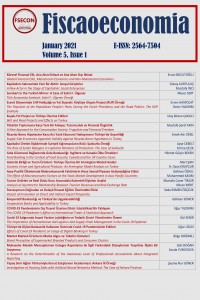Abstract
Kamu açıklarının finansmanında, kamusal borçlanma yolunun tercih edilmesinin özel kesimde servet artışına yol açacağı şeklinde görüşler oldukça yaygındır. Özel kesim servetindeki yükseliş, özel sektör harcamalarında artışa ve fiyatlar genel düzeyinde, üretim hacminde ve faiz oranlarında artışa yol açacaktır. Ricardo-Barro Hipotezi ekonomiye bu görüşten farklı bir bakış açısı sunarak, vergilerde ortaya çıkan değişim sonucunda görülen bütçe açığının finanse edilmesi yönünde gerçekleştirilen borçlanmanın, gelecek dönemde faiziyle birlikte ödenebilmesi için vergilerin artırılması gerektiğini ileri sürmüştür. Yani, bugün yapılan borçlanma (vergi indirimi) gelecekteki vergi artışını ifade etmektedir. Arz Yanlı Ekonomi Yaklaşımı, üretim hacminin artırılması için vergi oranlarının düşürülmesi gerektiğini önermekte ve bu yolla üretim artışının yanı sıra fiyatların düşeceğini, üretimin ucuzlayacağını vurgulamaktadır. Vergi indirimleri yoluyla daha fazla toplam vergi geliri elde edileceğini ileri süren Arz Yanlı Ekonomi Yaklaşımı, aynı zamanda kamu harcamalarının azaltılmasını, para arzının kısıtlanmasını ve piyasaya yönelik müdahalelerin zayıflatılarak özel kesimde sermaye birikiminin oluşmasını savunmaktadır. Çalışmanın amacını, Ricardo-Barro Hipotezi’ne karşı Arz Yanlı Ekonomi Yaklaşımı’nın Türkiye’de geçerli olup olmadığını tespit etmek ve bu yaklaşımlardan hangisinin öne sürdüğü etkilerin Türkiye’de daha fazla ortaya çıktığını tespit etmek oluşturmaktadır.
References
- Afonso, A. (2008), Euler Testing Ricardo and Barro in the EU. Economic Bulletin, 5,pp 1-14.
- Aktan, C. (1990), “Çağdaş İktisadi Düşünceler”, Dokuz Eylül Üniversitesi İktisadi ve İdari Bilimler Fakültesi Dergisi, Cilt:5, Sayı:1-2, 211-230.
- Aktan, C. (2009), Arz Yönlü İktisat Teorisi ve Haldun Laffer Etkisi, Ekonomi Bilimleri Dergisi, Cilt 1, Sayı 2.
- Ardıç, O., Erus, B. ve Soydan, G. (2010), “An Evaluation of Indirect Taxes in Turkey”, Economics Bulletin, 30(4), 2787-2801.
Abstract
It is quite common opinion that the choice of public borrowing in financing public deficits will lead to an increase in wealth in the private sector. The rise in private wealth will lead to an increase in private sector spending and an increase in the general level of prices, production volume and interest rates. The Ricardo-Barro Hypothesis presents a different perspective to the economy from this view and argued that the taxes should be increased so that the borrowing realized to finance the budget deficit as a result of the change in taxes can be paid with interest in the upcoming period. In other words, the borrowing made today (tax cut) represents the future tax increase. The Supply Side Economy Approach suggests that the tax rates should be lowered in order to increase the production volume and emphasizes that in this way, prices will decrease as well as production increase and production will be cheaper. The Supply Side Economy Approach, which asserts that more total tax revenues will be obtained through tax reductions, also advocates for the reduction of public expenditures, restriction of money supply and the creation of capital accumulation in the private sector by weakening market interventions. The aim of the study hypothesis against Ricardo-Barro Supply-Side Economics Approach to determine whether it is valid in Turkey and argued that the effects of which of these approaches is to identify that create more emerged in Turkey.
References
- Afonso, A. (2008), Euler Testing Ricardo and Barro in the EU. Economic Bulletin, 5,pp 1-14.
- Aktan, C. (1990), “Çağdaş İktisadi Düşünceler”, Dokuz Eylül Üniversitesi İktisadi ve İdari Bilimler Fakültesi Dergisi, Cilt:5, Sayı:1-2, 211-230.
- Aktan, C. (2009), Arz Yönlü İktisat Teorisi ve Haldun Laffer Etkisi, Ekonomi Bilimleri Dergisi, Cilt 1, Sayı 2.
- Ardıç, O., Erus, B. ve Soydan, G. (2010), “An Evaluation of Indirect Taxes in Turkey”, Economics Bulletin, 30(4), 2787-2801.
Details
| Primary Language | Turkish |
|---|---|
| Journal Section | Articles |
| Authors | |
| Publication Date | January 10, 2021 |
| Published in Issue | Year 2021 Volume: 5 Issue: 1 |



